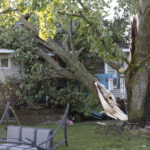The 127-ton tractor-trailer that derailed an Amtrak train at a railroad crossing in North Carolina was about three times the size and weight of a standard 18-wheeler, so huge it required a Highway Patrol escort, and so tall that it had to take back roads around some Interstate overpasses.
Authorities say the truck driver involved in Monday’s crash that injured 55 people was struggling to negotiate a tight left-hand turn across the tracks from one two-lane highway to another with this enormous load when the passenger train came roaring around a curve in the tiny community of Halifax, N.C.
A special state permit enabled the transport company to exceed length and weight limits as it hauled the electrical distribution facility made by PCX Corp. to New Jersey. It said the tractor and trailer was 164 feet long, with 13 axles to support the combined weight of 255,000 pounds. A standard 18-wheeler has five axles and tops out at 80,000 pounds.
“It was a big project,” Dean A. Di Lillo, a PCX Corp. vice president, told The Associated Press on Tuesday. He declined to put a value on Monday’s destruction.
An eyewitness said the driver was moving back and forth over the tracks trying to make the turn for about eight minutes before impact.
Between 30 and 35 passenger and freight trains use this stretch of CSX railroad daily, but no officials provided any indication that CSX or Amtrak was warned of the driver’s difficulties at the crossing.
“That’s all going to be part of the investigation,” CSX spokeswoman Kristin Seay said.
Amber Keeter, 19, stuck in traffic with her baby directly behind the tractor-trailer, told the AP that the crew spent a long time preparing to cross the tracks at the intersection of highways U.S. 301 and N.C. 903 in Halifax County, only to get stuck because of the load’s length.
She said she rolled down her window and asked a flag man if he could alert the railroad, but “he said he didn’t think so.”
Then, “the railroad lights started blinking, and so the tractor-trailer driver tried to gun it forward,” she said. The driver jumped out “just a couple of seconds before” the crash.
Well-established protocols require truck drivers and their trooper escorts to “clear their routes and inform the railroad dispatchers what they’re doing,” said Steve Ditmeyer, a former Federal Railroad Administration official who teaches railway management at Michigan State University. And even if they lose contact, a toll-free emergency number is prominently displayed at each crossing.
“That dispatcher would have immediately put up a red signal for Amtrak and radioed Amtrak to stop,” Ditmeyer said.
In this case, the train engineer “didn’t know about the truck until he was coming around a curve. He had no long vision,” Ditmeyer said.
Alerting the railroad wasn’t the responsibility of the trooper, who had only 25 seconds or so to react after the approaching New York-bound train set off warning lights and the crossing arms came down, North Carolina Highway Patrol Spokesman Lt. Jeff Gordon said.
The train’s conductor, Keenan Talley of Raleigh, was among the injured.
The truck driver, John Devin Black of Claremont, escaped without injury. The Associated Press was unable to reach Black on Tuesday. His listed phone numbers rang as disconnected. The rig owner and permit-holder, Guy M. Turner Inc. of Greensboro, did not respond to an email requesting comment.
Most of the passengers treated at hospitals were released by Tuesday. By then, about a dozen of the train’s 212 passengers had already continued their journey by bus to Richmond, Virginia, where they could take another train.
“We’re just thankful that we’re still alive. It could have been really worse. God was really with us,” said Lisa Carson, 50, of Philadelphia.
The Federal Railroad Administration’s database shows at least five previous collisions at the same Halifax crossing, all involving vehicles on the tracks. The most recent was in 2005, when a freight train hit a truck’s “utility trailer.” In 1977, an Amtrak train hit a car at 70 mph. The driver got out in time, but a railroad employee was injured, that accident report said.
Monday’s collision was the third serious train crash in less than two months. Crashes in New York and California in February killed a total of seven people and injured 30.
The Federal Railroad Administration is interviewing witnesses and reviewing onboard recorders as part of its investigation.
___
Drew reported from Halifax and Biesecker from Raleigh, N.C. Contributors include Martha Waggoner in Raleigh and Mitch Weiss in Charlotte, N.C.
Topics Auto North Carolina
Was this article valuable?
Here are more articles you may enjoy.


 After Years of Pushing Rate Hikes, Florida’s Citizens Now Wants HO Rate Decrease
After Years of Pushing Rate Hikes, Florida’s Citizens Now Wants HO Rate Decrease  Fifth La Niña in Six Years to Disrupt Crops and Supply Chains
Fifth La Niña in Six Years to Disrupt Crops and Supply Chains  One of Highest Property Claims Severity Recorded in Q3 on Low Volume, Says Verisk
One of Highest Property Claims Severity Recorded in Q3 on Low Volume, Says Verisk  Death at Universal’s Orlando Resort Roller Coaster Ruled Accidental
Death at Universal’s Orlando Resort Roller Coaster Ruled Accidental 

